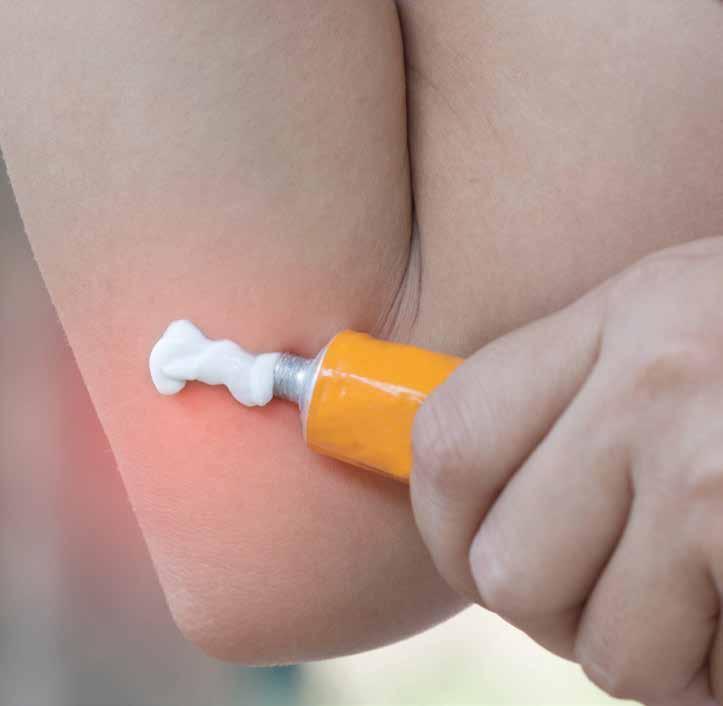
4 minute read
Head Pain
HEADACHE AND PAIN
Headache is a universal experience; most people will suffer with one at some point in their lives. Community pharmacy is ideally placed to support people with chronic health conditions such as headaches. Most headaches, including migraine which is very distressing, can be correctly diagnosed with appropriate over the counter remedies and/ or self-care advice provided in a community pharmacy by the community pharmacist and the wider team.
Research has shown that migraine is underdiagnosed and under treated in at least half of patients and that one-third of sufferers can experience significant disability as a result of their migraines at some stage of their lives.
TYPES OF HEADACHE
Chronic Daily Headache
Chronic Daily headache (CDH) is a descriptive term rather than a specific diagnosis. It can evolve from any primary headache disorder or can be de novo. Studies in the US and Europe indicate that 4-5% of the general population are affected by CDH. It is becoming more frequent and is a major reason for consultation in Headache/Migraine clinics. Much like migraine, CDH can significantly affect someone’s ability to function within the family, in society and in the workplace. In general, headaches occurring more often than fifteen days per month, over at least six months and lasting for four hours a day can be considered CDH.
People with chronic tension-type headache (CTTH) usually have a history of episodic tension-type headache but may also have no history of migraine. Many people use excessive amounts of analgesics and they may also have concomitant depression. The overuse of analgesics may convert episodic tension-type headaches into CTTH.
Tension-Type Headache
Tension-type headache is the most common type of primary headache with a lifetime prevalence of up to 78%. However, episodic tension-type headache requires little intervention from medical professionals as it rarely produces significant disability. It usually presents as a low impact, mild to moderate band-like featureless headache.
Patients with frequent episodic tension-type headache (1-15 days of TTH per month) often have co-existing Migraine without aura. Patients should be educated to differentiate between the two disorders and encouraged to use a Headache Diary to record individual episodes so that treatment can be maximised and medication-overuse headache avoided. neck or shoulder muscles may also hurt along with the headache. The pain can last from 30 minutes to several days, or may be continuous.
Cluster headache
The symptoms of cluster headache are characterised by unilateral (one sided) pain, although for some people the side can vary from time to time. The pain is usually centred over one eye, one temple or the forehead. It can spread to a larger area making diagnosis harder. During a bout of cluster headache the pain is often experienced at a similar time each day. The headache often starts at night waking people one to two hours after they have gone to sleep. The pain usually reaches its full intensity within 5 to 10 minutes and lasts at this agonising level for between 30 and 60 minutes. For some people the pain can last for 15 minutes, for others 3 hours has been known. It then stops, usually fairly abruptly. Sufferers may experience the head pain every other day during a bout, or up to 8 times per day during a bad cluster. In about 80% of people with cluster headache the bouts (or “clusters”) of head pain last for 4 to 12 weeks once a year often at the same time and often in the Spring or Autumn. It may then disappear for several months or even years. This is known as episodic cluster headache. The reason for this seasonal timing is not completely known, although it is one of the key aspects of diagnosis and may involve a brain area called the hypothalamus. The remaining 20% of people do not have these pain free intervals and are said to have “chronic cluster headache.”
People who use acute pain-relief medicine more than two or three times a week or more than 10 days out of the month can set off a cycle called ‘medication-overuse headaches’ (MOH). As each dose of medicine wears off, the pain comes back, leading them to take even more. MOH can occur with both over-the-counter and prescription pain-relief medicines. They can also occur whether taken for headache or for another type of pain. It is characteristic of migraine that people have episodic attacks of multiple symptoms (pain, nausea, vomiting, sensitivity to light and sound) but they go back to their usual state of health in between attacks. Medicationoveruse headache, in contrast, is a dull constant headache which is often worse in the morning. It is present on most days or part of every day. It is possible to have medication headaches most days with episodic migraine pain superimposed on the ‘headache’.
TREATMENT
Painkillers such as paracetamol, NSAIDs (aspirin, ibuprofen and diclofenac) and combined analgesics containing paracetamol can be used as first-line treatment to relieve pain from all headaches. There are also treatments that can be combined with paracetamol, such as buclizine and prochlorperazine to treat the nausea especially associated with migraine headaches. If the patient is nauseous a soluble painkiller may be recommended as these are absorbed quicker from the stomach. All over the counter treatments have legal licence specifications which the pharmacy must adhere to. This may sometimes be different from that which applies when the same medication is written on a prescription.










